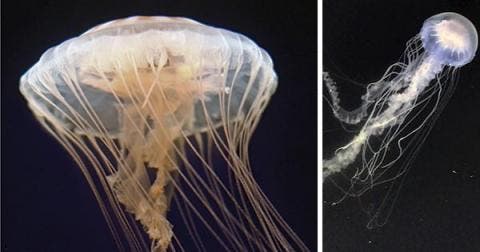Biologists at the University of Delaware discovered that a widespread and well-known jellyfish found along the U.S. East Coast is actually two distinct species.

Ever since it was first formally described 175 years ago, the common sea nettle jellyfish — which can be found in abundance in the Chesapeake Bay and Rehoboth Bay — has always been assumed to a be a single species. In took someone with a keen eye and a lot of patience like Keith Bayha, a University of Delaware alumnus and now a scientist for the Smithsonian’s National Museum of Natural History, for us to realize that this jellyfish is, in fact, two distinct species: an ocean-based species (which retains the name Chrysaora quinquecirrha, “sea nettle”) and a bay-based species (Chrysaora chesapeakei, “bay nettle”).
This insight was made possible thanks to the latest DNA sequencing techniques.
“Before DNA came along, people in museums looked at organisms and counted spines and bristles, measured things, and sorted organisms by their physical characteristics in order to identify species,” said University of Delaware professor Patrick Gaffney in a statement. “In the case of this jellyfish, which has been commonly known for centuries, Keith found through DNA sequencing that there were actually two groups.”
After genetic sequencing revealed significant differences in some of the sea nettle jellyfish, the scientists took a closer look at the physical characteristics of various individuals. As it turns out, the ocean-based sea nettle jellyfish is larger and has approximately 40 percent more tentacles (40, as compared to 24) than its bayside counterpart. What’s more, the ocean sea nettle has a larger bell and shorter tentacles than the bay nettle species.
“When you go back and pay close attention, you start counting the number of stinging cells and types, you see discrete differences that correspond to the DNA,” said Gaffney. “In many cases, when we plotted the data, the graphs looked entirely different with no overlap, reaffirming that it was two species.”
The findings published in the journal Peer J could have important implications, some of them commercial. For instance, bay nettle jellyfish prey on comb jellies called Mnemiopsis, which are predators of Eastern oyster larvae. The Eastern oyster, widely found on the Atlantic and Gulf Coasts, is the most consumed type of oyster. The industry could, for instance, propose measures that introduce more bay nettles to enhance Eastern oyster production. Another interesting find is that the bay nettle prefers less salty waters like estuaries. NOAA compiles a daily jellyfish forecast for the Chesapeake Bay, where jellyfish blooms can be a nuisance. The differences in the two species might explain why scientists found it particularly difficult to predict jellyfish bloom in the area very accurately.
“It’s not that I did anything that different, it’s just that no one else looked for a very long time,” Bayha said. “Jellyfish are something people don’t pay attention to because they’re fleeting. They come and go, are difficulty to study, and they don’t have hard parts like shells that wash up on shore.”






